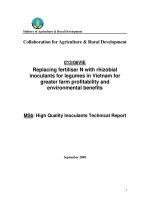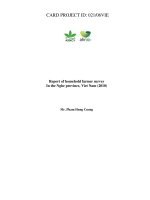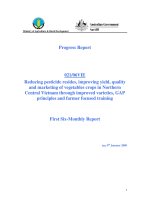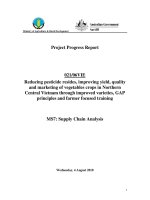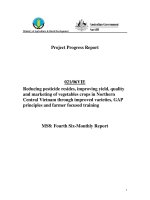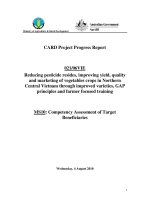Báo cáo khoa học nông nghiệp " Reducing pesticide resides, improving yield, quality and marketing of vegetables crops in Northern Central Vietnam through improved varieties, GAP principles and farmer focused training " First Six-Monthly Report docx
Bạn đang xem bản rút gọn của tài liệu. Xem và tải ngay bản đầy đủ của tài liệu tại đây (77.81 KB, 10 trang )
1
Ministry of Agriculture & Rural Development
Progress Report
021/06VIE
Reducing pesticide resides, improving yield, quality
and marketing of vegetables crops in Northern
Central Vietnam through improved varieties, GAP
principles and farmer focused training
First Six-Monthly Report
Date
9
th
January 2008
1
Table of Contents
1.
Institute Information ___________________________________________________ 2
2. Project Abstract _______________________________________________________ 3
3. Executive Summary ____________________________________________________ 3
4. Introduction & Background _____________________________________________ 4
5. Progress to Date _______________________________________________________ 6
5.1 Implementation Highlights ________________________________________________ 6
5.2 Smallholder Benefits______________________________________________________ 6
5.3 Capacity Building ________________________________________________________ 7
5.4 Publicity________________________________________________________________ 7
5.5 Project Management _____________________________________________________ 7
6. Report on Cross-Cutting Issues___________________________________________ 7
6.1 Environment ____________________________________________________________ 7
6.2 Gender and Social Issues __________________________________________________ 8
7. Implementation & Sustainability Issues ____________________________________ 8
7.1 Issues and Constraints ____________________________________________________ 8
7.2 Options_________________________________________________________________ 8
7.3 Sustainability____________________________________________________________ 8
8. Next Critical Steps _____________________________________________________ 8
9. Conclusion ___________________________________________________________ 9
10. Statutory Declaration___________________________Error! Bookmark not defined.
10.1 Appendix 1 Suggested Plans for Watermelon Trials in Vinh at ASINCV _____ Error!
Bookmark not defined.
2
1. Institute Information
Project Name
Reducing pesticide residues, improving yield, quality and marketing of
vegetable crops in Northern Central Vietnam through improved
varieties, GAP principles and farmer focused training
Vietnamese Institution
Agricultural Science Institute for Northern Central Vietnam.
(“ASINCV”), Nghi Kim, Vinh city,Nghe An province, Vietnam
Vietnamese Project Team
Leader
Dr Chuong
Australian Organisation
Applied Horticultural Research Pty. Ltd.(AHR) ACN 073 642 510, PO
Box 3114, Bundeena NSW 2230, Australia
Australian Personnel
Assoc Prof. Gordon Rogers
Date commenced
March 2007
Completion date
(original)
December 2009
Completion date
(revised)
Reporting period
1
st
March 2007 – 30
th
June 2007
Contact Officer(s)
In Australia: Team Leader
Name:
Assoc Prof. Gordon Rogers
Telephone:
0418 517 777
Position:
Project Leader
Fax:
+61 2 9544 3782
Organisation
AHR, Applied Horticultural
Research , PO Box 3114
Bundeena NSW 2230, Australia
Email:
In Australia: Administrative contact
Name:
Lynn Christie
Telephone:
+61 2 9527 0826
Position:
Administrator
Fax:
+61 2 9544 3782
Organisation
AHR, Applied Horticultural
Research, PO Box 3114,
Bundeena NSW 2230, Australia
Email:
In Vietnam
Name:
Dr Pham Van Chuong
Telephone:
+84 (903) 221 612
Position:
Team Leader Vietnam
Fax:
+84(0) 38 851 981
Organisation Agricultural Science Institute for
Northern Central Vietnam.
(“ASINCV”), Nghi Kim, Vinh city,
Nghe An province, Vietnam
Email: chuong.phamvan@gma
il.com
3
2. Project Abstract
3. Executive Summary
Vegetable farming in Vietnam can bring an attractive income of around 20-30 Million VND
per year which represents 80-90% of the average farming family income. There is potential to
increase these returns to growers by maximizing yield and quality of the produce they grow.
This project aims to improve the income of smallholders by encouraging them to adopt clean
and sustainable production practices. This will involve providing high yielding, disease
resistant varieties of watermelon and cabbage, providing information and training in Good
Agricultural Practice which will in turn help reduce chemical inputs and reduce postharvest
losses.
New varieties of watermelon were introduced and successfully grown for one season. Due to
the long negotiations over the contract the late start date meant that the plantings were later
than optimum. Nevertheless the watermelon was good quality and the first harvest was
successfully sold to Metro Cash and Carry in Hanoi. Unfortunately the monsoon destroyed
the later plantings and it was unmarketable. This was a very successful preliminary trial
which demonstrated the concept for the local growers and as a result they are keen to continue
working with the project to produce a crop of cabbages with planting starting in late October.
This preliminary trial;
• Demonstrated new marketing links between supermarkets (e.g. Metro Cash and
Carry initially) and farmers that will increase farmer income and result in higher
vegetable quality in retail outlets.
• Improved pre-harvest technologies to produce high quality cucurbit crops
• Improved quality standards and quality assurance cucurbit crops to meet market
expectations
Vegetable farming in Vietnam can bring an attractive income of around 20-30 Million VND per
year which represents 80-90% of the average farming family income. There is potential to
increase these returns to growers by maximizing yield and quality of the produce they grow. This
project aims to improve the income of smallholders by encouraging them to adopt clean and
sustainable production practices. This will involve providing high yielding; disease resistant
varieties of watermelon and cabbage, providing information and training in Good Agricultural
Practice which will in turn help reduce chemical inputs and reduce postharvest losses. The
introduction of new varieties and GAP will be implanted using a participatory approach with
farmer field days and workshops lead by leading Australian industry consultants. The project will
also facilitate the development of an effective supply chain which provides quality assurance for
buyers and a higher income for farmers. The project focus is on producing a better commercial
outcome for growers by facilitating the adoption of good agricultural practice and the
development of relationships along the supply chain.
4
4. Introduction & Background
Vegetable growing in Vietnam is an important source of income for the country and accounts
for 9% of the total cropping including rice. The major vegetables consumed in Vietnam are
KangKong, Brassica’s (cabbage, pak choi & kohlrabi) and various types of cucurbits (Anh,
Ali et al. 2004).
There is potential to increase these returns to growers by maximizing yield and quality of the
produce they grow. However, there are several aspects of the vegetable industry in Vietnam
which currently limit expansion and development of the industry and financial returns to
farmers, i.e.:
• High pesticide and nitrosamine residues in produce
• Postharvest temperature management and handling technology limits the quality
presented to consumers
• Agronomic practices used by growers can limit potential yields and hence farmer
income
• Traditional marketing can limit farmer returns
One of the key issues is the high level of pesticide residue on fresh produce grown in
Vietnam. A recent study has shown that up to 22% of the vegetables consumed in Vietnam
may be unsafe to eat because of pesticide residues, heavy metal contamination and high
nitrosamine levels (Health and Life, No. 204, Nov. 2002). In Hanoi, 9% of vegetable samples
exceed pesticide residue limits and 7% have residues of banned pesticides (Moustier, Bridger
et al. 2002; Anh, Ali et al. 2004). In addition to pesticide residues, nitrate levels in vegetable
products are commonly several times higher than permitted levels (Thatch 1999), and are
caused by the use of excessive nitrogenous fertilizer (Thi 1999; Thi 2000; Ha and Ali 2005).
Despite the heavy pesticide use, significant proportions of crop yields are lost to pests and
diseases e.g. 25% of leafy vegetables, 23% of cucurbits and 32% of brassicas (Anh, Ali et al.
2004). One factor which further complicates the pesticide residue issue, is that constant high
humidity (>75%) in many growing areas encourages foliage diseases and fungicide spraying
to control these diseases (Anh, Ali et al. 2004).
The project will use a participatory approach to encourage the uptake of good agricultural
practices (GAP) by the collaborating Vietnamese Institutes and the stakeholders (farmers,
extension staff and commercial partners). The project will include several training initiatives.
These include the establishment of demonstration variety and GAP trials which will be the
basis of farmer field days, postharvest research investigating temperature management and
packaging along the supply chain, intensive training of Vietnamese horticulturalists in
Australia and the delivery of a large workshop at the end of the project to ensure the
information is available to as wide an audience as possible.
There will also be workshops involving the collaborating farmers, Institutes and commercial
buyers that will develop quality standards and quality assurance programs for the supply
chain identified. Mr John Baker from Produce Marketing Australia (PMA) will facilitate that
part of the project as he has extensive experience in developing markets for Australian,
American and Vietnamese growers.
The aim is to develop a new and reliable market for growers by establishing supply chain
links with Metro supermarkets. This will mean that the number of steps in the supply chain
will be reduced and the product will reach the final customers more quickly, resulting in a
fresher product with increased demand and sales. As a result, farmers will benefit through
increased sales, more reliable markets, better communication with product buyers and in turn
5
better returns. Retailers benefit through reliable supplies of consistent clean product that
meets their specifications and thus improving their sales and returns.
The project is focussed on outdoor farmers adopting methods to produce clean high quality
vegetables by:
1. New varieties: Introducing and evaluating new varieties with good pest and disease
resistance, and agronomic characteristics in field trials at ASINCV at ASINCV in Vinh
City, Nghe An province. These trials will be used to select the best performing new
varieties.
Disease resistant varieties will be sourced from seed companies such as: EastWest
(Vietnam), Long Hoang Gia Seeds Ltd, Syngetnta seeds, and AVRDC. Evaluation trials
will include varieties such as:
• Cabbage: BC76; SG129; SG130; WCA443; Kilaherb; Quisto; Gloria; Gospel
F1; KK Cross; KK Cross (for common standard); Green Helmet.
• Watermelon: Hoang Gia 350 F1 (resistant to anthracnose); Queen Bee 170 F1
(resistant to powdery mildew and anthracnose); Red Tiger (resistant to
anthracnose race 1 and fusarium race 0 and 1).
2. A Good Agricultural Practice manual will be developed collaboratively between
Vietnamese and Australian teams for two major annual crop groups: cucurbits and
brassicas. The manual will be a practical guide and will include information on varietal
selection and evaluation; water management; crop nutrition; crop scheduling; effective
pest and disease management including insect scouting; and, correct postharvest handling
(i.e. harvest maturity, temperature management, grading, transport and packaging). The
integrated pest management aspects will be handled by the ASINCV Integrated pest
management (IPM) department Nguyen Duc Thang, Tran Thuy Van, and Nguyen Quang
Huy.
3. Participatory Training: The training component is targeted at several levels but all
cases use a participatory approach. The field trials provide training on experimental
design and management as well as providing resources for growers for the field days. The
production of the GAP manual provides information that can be used in Farmer Field
Schools. The Farmer Field Schools will be run by ASINCV and RIFAV, and co-
ordinated by Nguyen Quang Hao and Phan Van Vinh of the Extension and Technology
Transfer Department at ASINCV.
4. Postharvest Research and Training: Postharvest research into the temperature profile
of products through the supply chain will highlight areas for improvement in packaging
and package orientation within the truck to reduce temperature build up during transport.
This research is the first step in mapping the supply chain to determine areas for
improvement. Quality Standards will be developed for the new varieties introduced.
Vietnamese researchers will also be trained in the Fresh Care Quality Assurance system
(NSW Dept Primary Industry) and a similar QA system will be initiated for participating
farmers in this project. ASINCV and RIFAV Departments of Postharvest Technology
and Postharvest Physiology respectively will play a key role in the postharvest aspects of
the project.
5. Developing supply chain links with the supermarket Metro. The Australian team will
co-ordinate and help set up the marketing linkages between Metro and the farmers. This
link will be crucial because the higher standards required by Metro and the associated
6
higher returns to growers will be the incentive for farmers to adopt the new techniques.
These supply chain linkages will be appropriately mapped.
5. Progress to Date
5.1 Implementation Highlights
i. CARD contract signed:
The project was officially signed on the 10
th
March 2007. This was after a novation
agreement between the University of Sydney and Applied Horticultural Research Ltd.
A planning meeting was held with all parties in Hanoi and Vinh City during the week
of the 25
th
– 31
st
March 2007.
ii. Training Vietnamese scientists in Australia
Two Vietnamese scientist, who were nominated from ASINCV, visited Australia
from the 12
th
– 18
th
August 2007. The scientists visited Australian growers and
markets. They also worked with the Australian partners to develop aspects of the GAP
manual and particularly the quality assurance aspects based on the NSW Department
of Primary Industries FreshCare
®
program.
iii. Watermelon varieties planted and harvested
The first watermelon plantings were planted on the 1
st
planting occurred on 31
st
May
2007. Heavy rain which delayed planting also reduced seedling emergence. There was
an estimated 50% germination.
The 2
nd
planting seeded in the nursery around the 31
st
May and was transplanted into
the field on the 13
th
June 2007. The 3
rd
planting was transplanted about 10 days later
(23
rd
June). Dr Rogers visited Vinh City on the 15
th
-22
nd
July to help supervise the
planting/harvesting of the trial.
This trial was an important preliminary trial which highlighted the issues in terms of
the seasonality of the Nghe An province. It also allowed all collaborators to get the
contracts and logistics in place for future shipments.
iv. Baseline survey drafted
The questionnaire for the baseline survey of farmers has been completed and
translated into Vietnamese. The survey won’t be completed by December 2007 as Mr
Cuong would like to survey farmers during the production season for cabbages which
runs from October to March. This means that the information will be fresh in their
minds and our data will be more accurate.
5.2 Smallholder Benefits
New varieties of watermelon were introduced and successfully grown for one season.
Due to the long negotiations over the contract the late start date meant that the
plantings were later than optimum. Nevertheless the watermelon was good quality and
the first harvest was sold to Metro on the 31
st
July. Unfortunately the monsoon
destroyed the later plantings and it was unmarketable. This was a very successful
preliminary trial which demonstrated the concept for the local growers and as a result
7
they are keen to continue working with the project to produce a crop of cabbages with
planting starting in late October.
This preliminary trial;
• Demonstrated new marketing links between supermarkets (e.g. Metro Cash and
Carry initially) and farmers that will increase farmer income and result in higher
vegetable quality in retail outlets.
• Improved pre-harvest technologies to produce high quality cucurbit crops
• Improved quality standards and quality assurance cucurbit crops to meet market
expectations
5.3 Capacity Building
Two Vietnamese scientists were invited to Australia in August 2007 and they have
increased their understanding of brassica and cucurbit production and quality
assurance.
Growers that participated in the first trials have also developed their agricultural
production skills and have been introduced to a new market and supply chain which
they can build on in future trials.
5.4 Publicity
Information has been disseminated through the Farmer Field School program and by
workshops held during Dr Rogers visit in July 2007.
5.5 Project Management
Administration of money will be carried out by the Applied Horticultural Research
Ltd (AHR) following a novation agreement with the University of Sydney research
office on the 10
th
March 2007.
The Agricultural Science Institute of Northern Central Vietnam (ASINCV) is the lead
organisation in Vietnam ASINCV conducts research in the field of agricultural
science and technology with the aim to develop the socio-economy of Northern
Central Vietnam.
During the initial meeting in March the Vietnamese and Australian team member
roles within the project were finalised and sub-contract agreements between AHR and
our Vietnamese collaborators were prepared and signed
6. Report on Cross-Cutting Issues
6.1 Environment
The introduction of improved watermelon varieties and sustainable production techniques
will improve the environment in vegetable growing regions and reduce pesticide use. Farmers
with better varieties, more knowledge and better market access have more control over the
8
production system and have an incentive to prevent unnecessary applications of fungicides.
GAP also ensures farmers safe use of chemicals which protects the health of faming
communities as well as the environment.
6.2 Gender and Social Issues
The market development should ensure better on-farm prices, through reduction in the
number of intermediaries and/or through increased power to farmers rather than
brokers. Farm incomes will therefore increase, and result in better standard of living
for rural workers in particular women.
7. Implementation & Sustainability Issues
7.1 Issues and Constraints
Extended contract negotiations have delayed the implementation of the project. This
has resulted in a renegotiation of the project milestones.
7.2 Options
Nil
7.3 Sustainability
The initial trials have shown the proposed methodology is achievable and we are
encouraged to continue. A longer lead time for planning the next crop of cabbages
should mean we have a greater success in the marker for this product.
8. Next Critical Steps
1. Organise and manage the cabbage production and trials in Nghe An province
2. Design and carryout the baseline survey of farm production systems
3. Develop a GAP manual for Brassica and Cucurbit crops
4. Update the postharvest information on the Postharvest training CD from a
previous CARD project. After the first 6 months of the project the project
team has decided that it is important to provide information in a format that is
useful for growers and marketers and it is still not clear whether updated
information on the Postharvest CD is going to be as useful as originally
planned. It may be better to develop a CD that uses an html format allowing
links between production sections, project research results and even relevant
videos and photos that relate more specifically to the cops and supply chain
we are developing during the life of the project.
5. Complete the baseline survey of farmers. This will be completed in March
2008 rather than December 2007. The team feels that better data will be
collected if it is collected during the production season when the information
is fresh in farmer’s minds rather than recalling events. The first cabbage
season runs from October 2007 until March 2008.
9
9. Conclusion
The project commenced on the 1st March 2007, 3 months later than the original
proposed start date of January 2007. The delayed start meant that the first crop of
watermelons was planted later than the optimum time. Despite this the initial crop was
an important learning experience for all concerned and has provided many
opportunities for improving the proposed supply chain for future crops.
In the first six months the Vietnamese and Australian team member roles within the
project have been finalised. Two Vietnamese scientists have visited Australia and
have undertaken intensive training in crop production and quality assurance
management and most importantly the first trial of watermelons was grown, harvested
and sold to Metro Cash and carry in Hanoi.

